What’s Trending: Virtual Reality, Augmented Reality, and Mixed Reality (Really?)
MHL LLC Staff Writer
January 4, 2017
I am sure by now that most readers have seen a TV commercial with an actress or actor wearing a Virtual Reality (VR) headset. Others have probably played Pokemon Go, which introduced Augmented Reality (AR) to the masses, and oh-by-the-way is also the most successful U.S. game of all time, reaching $600 million in revenue, in 3 months.
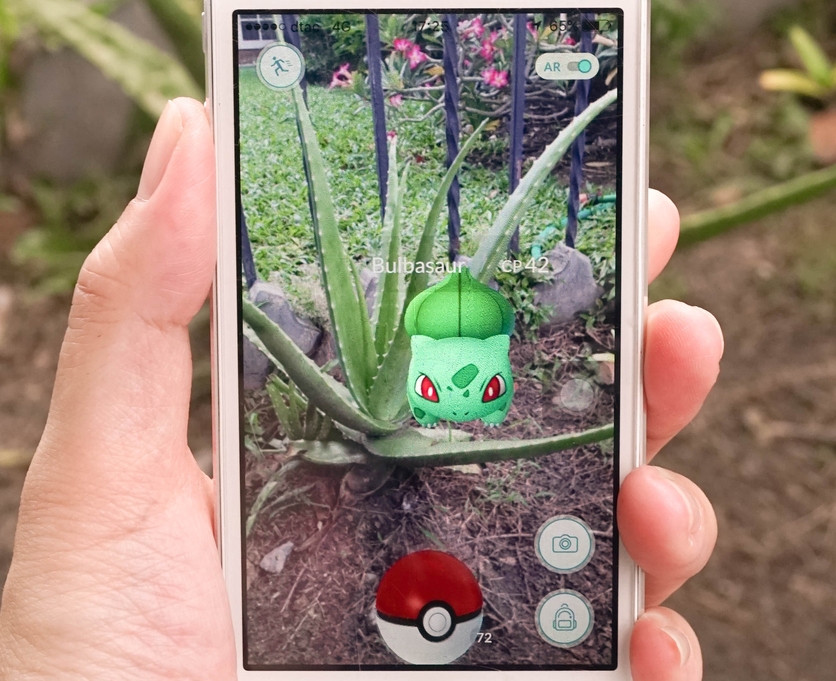
The main difference between VR and AR is the latter uses your real environment as a background for placing objects. VR is completely virtual, immersion, another world. AR is gaming and other objects like maps being overlaid on your current environment.
You have may have used AR, and not even realized it. Does your computer or phone allow you to put on virtual hats while you are video chatting? This is just one example of AR, in this case, you are augmenting the reality of the “far end” of the video call (the person or group you are talking to).
Another example of Augmented Reality is the Ikea App, which allows users to place virtual solid objects in their home, to see how they look with their existing furnishings. Check it out at: IKEA AR App Youtube Video
But this is just the beginning of where VR and AR might go. Developers are scrambling to be the first to market with object oriented software specifically designed for the Microsoft HoloLens AR headset. For example, Rosstin Murphy, an IBM engineer, has been developing software that lets the end user visualize the data from IBM’s analysis tools using the MS HoloLens. Check out a video of his work at: VR/AR Data Visualization Youtube Video
Wait, what about audio? Listen closely the next time an ambulance or fire truck goes by, you will hear the siren frequency drop, due to the Doppler Effect. As we walk around these virtual worlds, the audio needs to follow. As a police car goes by, we need to hear the Doppler effect of the siren, and that changes if we are in a car or stationary. Pyschoacoustics is nothing new; surround sound can be physical and/or virtual. Thunder can come from above, footsteps from below, in a full 3D space, using just a headset. But imagine having your own personal headset that is customized to your own hearing, and the shape of your ear, so when you plug in your headset, your “audio relationship” with the room will be more natural.
To achieve this new reality, whether VR or AR, large and increasing amounts of data need to transmitted to the headset. We will dig into this topic some more in future blogs.
High Resolution Over Long Cables – A Challenge For Display Interface Ecosystem
MHL LLC Staff Writer
November 28, 2016
When I grew up, many teenagers were upgrading their car stereos. I watched my brother and his friends install huge power amplifiers and subwoofer boxes in their trunks. That same brother taught me how a coil of copper could be used as a low pass filter, cutting out the higher frequencies from the subwoofer. We did not know how it worked, it just worked. It was not until years later, when in college, that I learned about inductors, RLC crossover networks, and transmission lines. Fast forward to today. The same principle that a cable is a low pass filter is appearing again. This time, as display interfaces need to deliver increasing resolution. Read on to learn more.
.jpg?n=9617)
Today’s Display Interfaces Are Digital, That Helps, Right?
Modern display standards digitize video signals, which changes the way we experience attenuation. One advantage of digitization is that subtle distortions and degradations do not occur. However, attenuation is still present and once the signal has been attenuated sufficiently it will not be received correctly and the interface will stop working. Techniques such as Forward Error Correction (FEC) can help make links more reliable by improving immunity to noise but they cannot remove the impact of attenuation.
Higher Resolutions Increase Attenuation
When digitized display interfaces were first introduced they seemed to solve all of our display connectivity problems. Strange distortions at the edge of the screen, ghosting and color variations all disappeared. And at the resolutions in use at the time, attenuation was only a problem at many tens of feet. However, over the past 15 years display resolutions have increased rapidly. To move all this additional information frequencies have been increased. This takes me back to what I learned in my car audio installation days. Copper cables act as a low pass filter. So as frequency goes up so does attenuation. This reduces the maximum cable length.
Quantifying Impact on Cable Length
There is no one answer as to how far a digital interface can drive. It depends on the standard and the quality of the cable. For example with HDMI 1.0 we see that 30 feet cables are fairly common, while with HDMI 2.0 cable length seems limited to about 20 feet due to the higher frequencies. USB is also interesting to review; it has undergone similar changes in maximum cable length as frequencies have increased:
- USB 2.0 5 meters (480 Mbps)
- USB Type C 2 meters (5 Gbps)
- USB Type C 1 meters (10 Gbps)
Delivering Longer Cable Length
There are three basic techniques that are used to improve video and data losses due to cable length:
- Active Electrical Cables, which amplify the signal at one or more points in the cable.
- Active Optical Cables, which convert the electrical signals to optical for transmission and then back to electrical at the receiver.
- Using more data conductors which results in higher bandwidth without higher frequencies.
As the road to 8K displays is paved over the next few years, and bandwidth continues to increase, the display interface ecosystem will need to consider each of these solutions when determining how to deliver more data over longer cable lengths. Clearly the display interface ecosystem has lots of decisions and tradeoffs before it. One thing is for sure, it will be an exciting few years as we collectively chart a course forward.
NHK Passes the 8K Broadcast Test and Takes Gold in Rio with “Super Hi-Vision” Broadcast
MHL, LLC Staff
September 13, 2016
I remember the first time I saw a boxing match in “Widescreen HD.” It was broadcast in 720p. I was blown away. Soon after, I got my first 1080p television, and I thought sports teams would never look better. Wrong again. My buddy upgraded to 120Hz, another friend to 240Hz, and then I saw 4K…
What’s next? The answer is 8K, which is the common name for 7680x4320 resolution. 8K television broadcasting is coming to the home quickly, and many companies around the world are racing to get there first. Last month, Japanese broadcaster NHK reached a major milestone on the road to 8K-television broadcast, by successfully testing and delivering a full 8K broadcast of the Olympic Games in Rio.
About 60 branch locations of NHK offered viewers the chance to experience the 8K Olympics first hand using Sharp 85inch 8K TVs in each location. There was also some Olympic-sized viewing at NHK Shibuya in Tokyo, which has a 520 inch screen and four Panasonic DLP 4K laser projectors, and supports the 22.2ch audio of 8K. 520 inches is 43.3 feet or 13.2 meters. When a projection screen gets that big, and you are only using 1080p, viewers start to notice the pixels, but with 8K, the pixels are much smaller. To give you some perspective on how many more pixels are in an 8K signal, check out this graphic below.
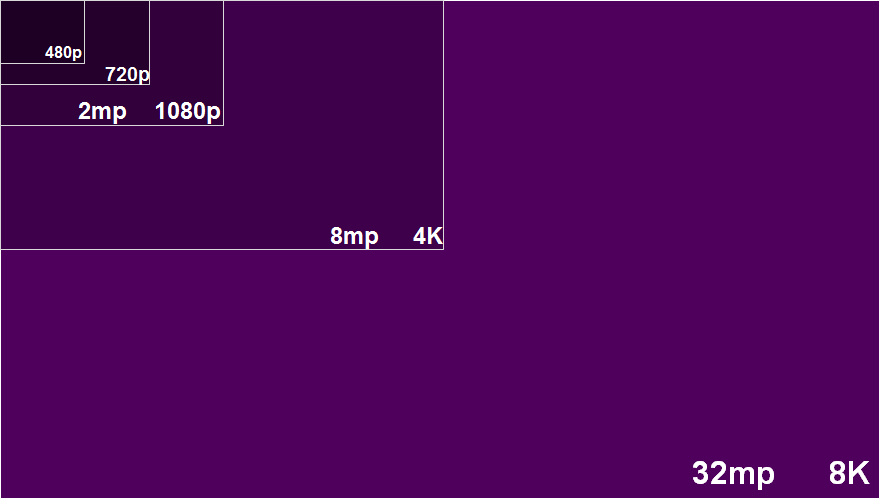
You can imagine the bandwidth needed to broadcast an 8K signal over satellite. To get the data rates and bandwidth needed to transmit the signal successfully, NHK used an 8K codec system with HEVC/H.265 coding scheme. The 8K specifications allows for up to 120fps (frames per second), but 8K is not just about video, it is also about audio. In past years, the onsite audio-production facility was not designed for the 22.2 channel capability that 8k broadcast can offer, but this year a variety of microphones and special microphone trees with 8 to 12 different microphones were carefully rigged from the ceiling of the Olympic venues, providing unsurpassed surround sound audio capabilities.
The recent 8K broadcasts of the Rio Olympics marked a major milestone on the road to 8K broadcasting. Just like the athletes who pushed their own limits, and who broke their own personal records, NHK set the bar higher by broadcasting the highest resolution of a live sporting event. And just like the Olympics, the road to 8K does not end in Rio. NHK hopes to replace the test broadcasts with limited direct-to-home transmissions in 2018 and full coverage of the 2020 Tokyo Olympics.
Still don’t believe that 8K is the next big thing in TV? Tell me, how many pixels does your smart phone have in its screen, or camera? How many did it have 4 years ago? What about 4 years before that? Just like your mobile phone and laptop computer screens are getting better, so will television. I grew up with a black and white TV hooked up to a Commodore 64. Now my 42” 1080p LCD TV is the dinosaur and, it’s not even 10 years old. They grow up so fast! And just like your kids, that 10-year-old 1080p TV will soon move out, get a 4K degree, and eventually come back home, with live 8K television content (and maybe some laundry).
Click here to learn more about MHL.
Want to read more about the 8K broadcast in Rio 2016? Check out these related stories:
Article 1
Article 2
Article 3
Create and Connect This Semester With MHL
MHL, LLC Staff
August 29, 2016
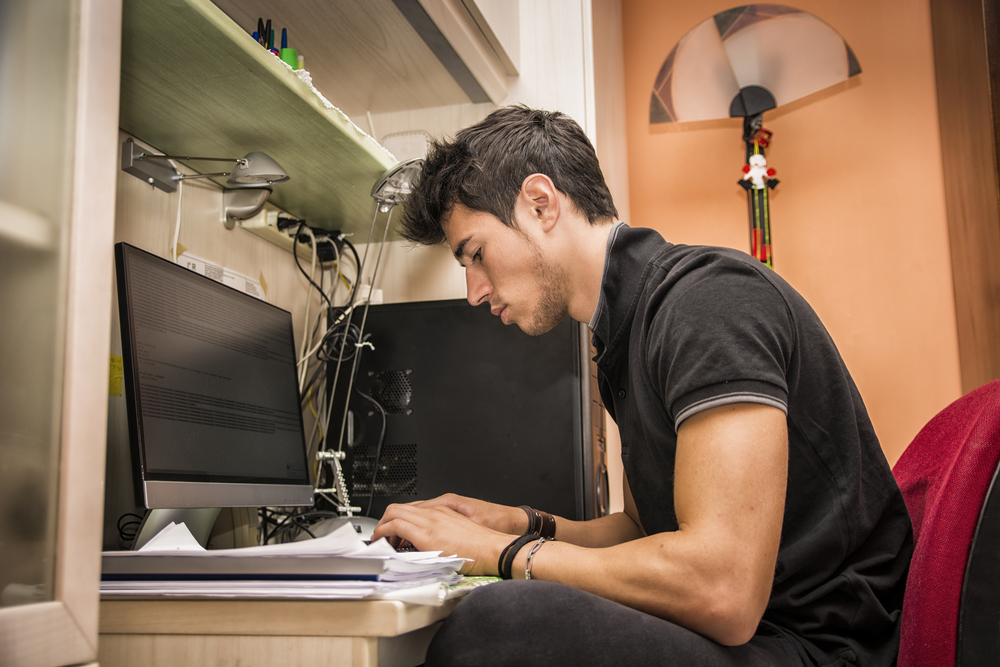
If you are a student who is heading back to school this fall, you have probably already spent a small fortune on the essentials for life in the dorms. These items might include a small refrigerator, a reading lamp, a corkboard, not to mention all of the books, notebooks, software and study guides you have to buy for your classes.
One essential thing that is easy to pack is MHL®, which stands for Mobile High-Definition Link. MHL allows you to connect certain Android smartphones to your computer monitor or big screen TV using a single connection that also simultaneously charges your phone. Here are a few ways MHL can help:
Dude, I spilled Mountain Dew on my Macbook! - We have all been there. One minute, you are finishing up your formal lab report. The next minute, you and your laptop are covered in soda, or coffee. The keyboard stops working, and if you are lucky, you can power it down safely and get it fixed. So what do you do in the meantime? MHL allows you to pair your phone with a Bluetooth keyboard and mouse and you can use mobile versions of Microsoft Office to finish up your essays. View PowerPoints, lecture recordings, and other class notes on your TV as you lay on the couch (just don’t fall asleep) Your phone can do nearly everything that your laptop can do, if you know how. MHL Productivity Blog Part 1 & MHL Productivity Blog Part 2
No way that’s your high score - A car racing whizz in Asphalt 8 or CSR2 and want to show your new dorm friends your skills? Or perhaps you are more retro and want to demo your Sonic the Hedgehog skills? Whatever your mobile gaming passion you can use MHL to share to the big screen. Level Up With MHL
You order the pizza, I will setup the projector - Instead of binge watching Game of Thrones on your little laptop screen, buy a projector, hang up a sheet, and make a mini movie theater in your dorm room. MHL works with Netflix, Roku, Google Play, Amazon Prime, and most other online video streaming services.
One of the biggest bonuses of MHL is that your phone continues to charge while you are using it for any of the above scenarios. Gaming, movies, Microsoft Office, all of these can wear down your phone battery. But with MHL, your phone is charged.
Sound like MHL could help out this semester. Check out the list of phones, TVs, Projectors and Monitors that support MHL here Devices Supporting MHL
Level Up with MHL
MHL, LLC Staff
July 22, 2016
What comes to mind when you hear the phrase “mobile gaming”? Angry Birds? Game of War? Well for many of us at MHL, it’s Sonic The Hedgehog. What you may not realize is that you can play Sonic and other classic gaming titles on your Android phone using a Bluetooth gaming controller that is laid out a lot like the classic gaming console controllers. If your phone supports MHL you can also use your TV as the display. We recently tested out two such controllers the MOGA PRO and MOGA PRO 2.
When you get home, you can switch to the big screen using a MHL cable or adapter, which streams the Android Smartphone video in full 1080p resolution (4K for some phones) and keeps charging your phone while you play. The MHL connection also supports multi-channel audio (up to 7.1 surround sound.) Not sure if your phone supports MHL, you can check here http://www.mhltech.org/devices.aspx.
The first step to using these controllers is to turn on your Bluetooth in your phone or tablet and scan for new devices while powering on your controller by moving the switch to the A or B position (most apps use A, and the app will tell you when to use B.) You should be able to see your controller show up in the list of “Found” devices and then pair it. (See screenshot below.)
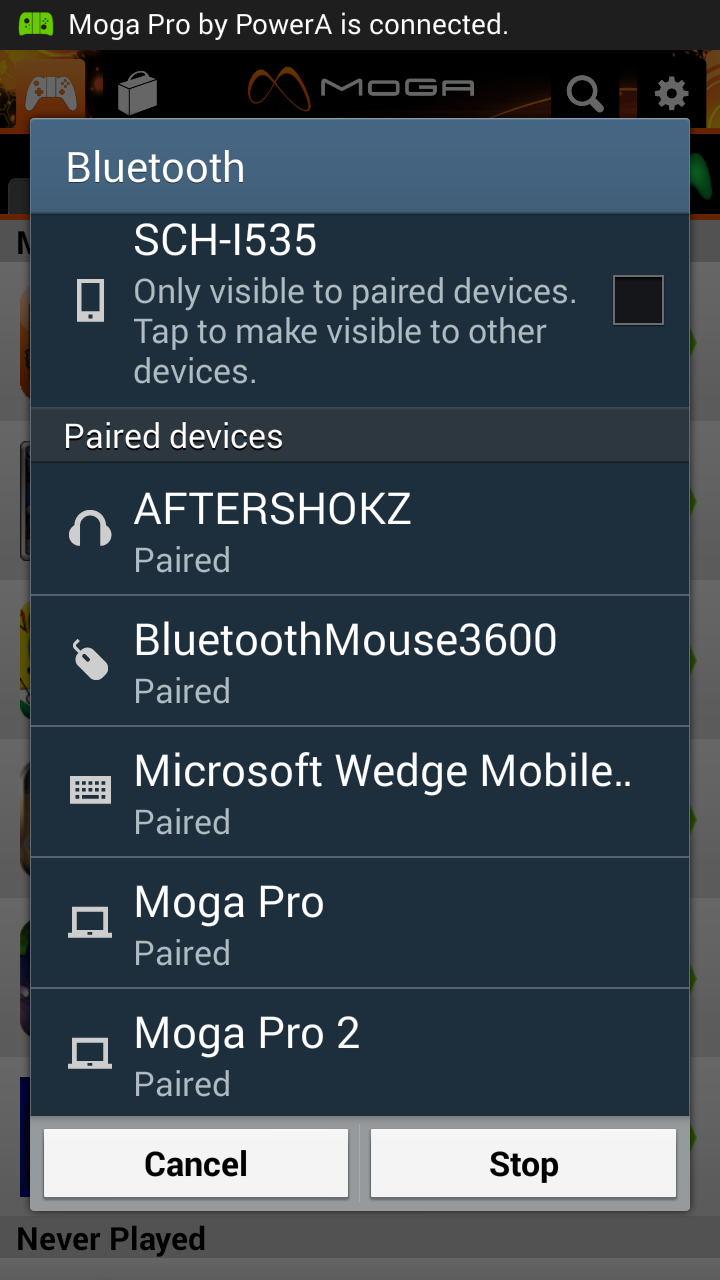
When your Android phone or tablet has been properly paired with the controller via Bluetooth, you next need to run the corresponding app. For The MOGA devices, it’s called the MOGA Pivot. The app will make sure that your controller is properly synced up with your phone, and also serves as a “mini-marketplace” for downloading compatible games.

One game we tested was Sega’s Virtua Tennis Challenge, which like many Android games, allows you to test drive the game for free, by completing the half dozen tennis lessons (which teach you how to play) and then playing in one real tennis match. The Virtua Tennis Challenge really takes advantage of the various buttons on the blue-tooth controller, allowing you to smash, lob, or send a powerful serve to different areas of your opponents court. Combine this advanced gaming interface with an MHL connection, some good speakers, and a comfy couch or recliner, and you will quickly forget you are playing a video game on your phone.
In addition to various Sonic games, Zen Pinball, and Virtua Tennis Challenge, we tested out the controllers on some other titles like Stupid Zombies 2, Tiny Little Racing 1 and 2, and Jet Set Radio, Soulcraft, and retro “Tony Crack” type skateboarding game. The controllers worked well although for best results we recommend pairing a single controller at a time.
Pro Tip -- If you get a Bluetooth gaming controller like the MOGA Pro or PRO2, the first thing you should do is download the corresponding app AND update the firmware.
The bottom line is playing mobile games using a Bluetooth controller and MHL connection is a blast and certainly beats blowing the dust out of a Sega Genesis cartridge.
Enabling High Performance Video Over USB Type-C With MHL/superMHL
MHL, LLC Staff
July 1, 2016
.jpg)
Just when you thought you knew everything you needed to know about USB…the new USB Type C comes along. The new USB Type-C is a both a new connector and a new standard in device connectivity. It combines power, control, audio, and video signals into one universal connector for computers, mobile devices, even IoT devices like USB powered light fixtures.
Before we delve into the benefits of the new USB type C, let’s quickly review USB Type A and B. The first USB 1.0 connectors debuted about 20 years ago. The Type A connector plugged into your computer (technically known as the ‘host’) and the Type-B connector would plug into your printer or scanner (also known as a ‘device’).
Consumers quickly learned about miniaturized versions of the USB connector, mini-USB and micro-USB; the lesson often learned soon after they misplaced their phone charger and needed to borrow or buy a new USB cable to charge their phone.
The USB Type-C interface specification promises to change the way computers, consumer electronics and mobile devices connect and interact. The slim, rugged and reversible Type-C connector extends the capabilities introduced by the USB 3.1 SuperSpeed+ specification by using up to 2 USB 3.1 interfaces to provide a total bandwidth of potentially 20Gbps. This allows faster transfer and streaming of large files such as HD movies and 3D images.
USB Type-C’s high-power capabilities mean it can supply up to 100W to allow fast battery charging and the provision of power to larger devices such as laptops, monitors and TVs. Type-C also introduces several other unique features, including new Alternate Modes which can enable the USB connector and cable to carry other content like video streams; although so far, only DisplayPort and MHL®/superMHL® Alternate Modes have been defined.
To help foster the innovation and adoption of USB Type-C and MHL superMHL in phones, MediaTek and Lattice Semiconductor recently released power-efficient reference designs that drive 4K UHD over a USB Type-C connector. Lattice’s USB Type-C port controllers and MHL transceivers can easily be paired with MediaTek’s Helio™ X20, the world’s first mobile processor with Tri-Cluster™ CPU architecture and ten processing cores (Deca-core). Read the press release here. http://www.latticesemi.com/en/About/Newsroom/PressReleases/2016/201603144KVideooverUSBTypeC.aspx
The Content Revolution and What It Means for superMHL
MHL, LLC Staff
June 20, 2016
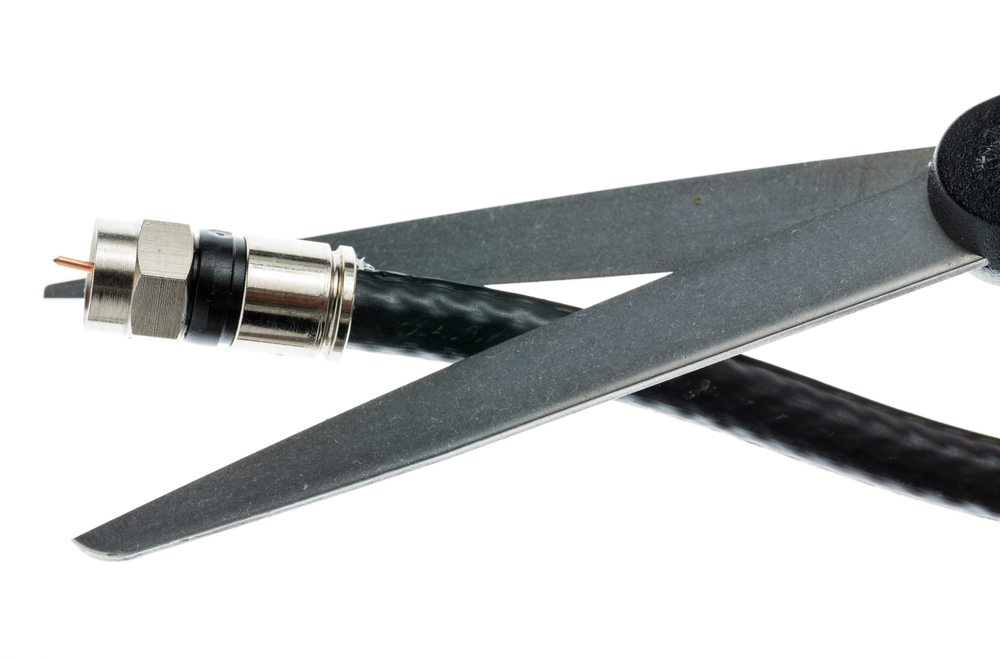
There’s a revolution happening in digital content, and it’s having a profound effect on how consumers store, access and view/listen to their pictures, TV shows, movies and music. Let’s take a moment to examine why this revolution is happening and what it means for the future of MHL.
Cord Cutting – As more consumers get used to the convenience of streaming media, there’s been a decrease in demand for traditional content distribution models (broadcast, satellite, cable). Consumers are happily ditching their cable and satellite plans, particularly younger users, and getting their content via the Internet.
4K Content – While the broadcast networks aren’t quite ready to take 4K mainstream (in their defense, they have a lot of infrastructure that needs updating to support 4K), the streaming services are already offering 4K content. As compression technologies improve and broadband Internet speeds rise, it’s now easy to deliver 4K video streams to any consumer with a broadband connection. This is also having a profound effect on DVD and downloadable music sales as it becomes more cost-effective for consumers to get their content via a streaming service with a low monthly subscription fee.
Mobile Broadband – Mobile broadband makes it easy to enjoy video in real time, and its proven to be the major consumer of precious megabytes for most mobile data plans. However, T-Mobile recently announced a mobile broadband package where customers can stream content for many popular streaming apps (Netflix, YouTube, Spotify, Hulu and others) with no data charges. This is sure to attract the attention of tablet and smartphone users, particularly those in metropolitan regions where LTE and other mobile broadband technologies are readily available. If other service provides follow suit, mobile broadband may soon be the delivery method of choice for the vast majority of consumers, even replacing wired broadband connections to the home.
Mobile Technology – As Moore’s Law continues to make processing both inexpensive and powerful and smartphones/tablets have become indispensable part of many consumers’ daily lives, OEMs continue to launch increasingly powerful mobile devices that are becoming the primary platform for content consumption.
So, as we take into account each of these developments driving the content revolution, it would appear the new norm for consuming digital content is to stream high-resolution video to a mobile device. But the one thing a mobile device can’t do is provide that content in a big screen format, one that allows content to be shared. Sounds like a job for superMHL, doesn’t it?
With superMHL-enabled devices and a superMHL cable, consumers can quickly connect their mobile devices to a 4K display or projector to take their mobile experience to the big screen. Unlike wireless approaches, it doesn’t require wrestling with WiFi settings or potentially exposing your mobile device to cyberattack through unsecure public WiFi networks. And only superMHL currently has the technical ability to present 4K content at a full 120 fps (in addition to supporting HD audio, high-speed data and device charging all over one cable).
With superMHL, streaming 4K content and low-cost mobile broadband, consumers could replicate the same content experience that used to require set-top boxes, DVD players and cable modems with a smartphone, a mobile data plan and an MHL-enabled HDTV or display. Ain’t technology grand?